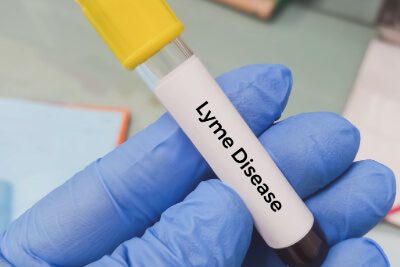Protecting Your Dog from Lyme Disease in Ontario
Lyme disease is caused by Borrelia burgdorferi(Bb), a bacterial infection that is spread through the bite of infected blacklegged ticks (Ixodes scapularis). This disease is a growing concern for Ontario dogs, especially in southern and eastern regions. Read on to learn how you can protect your dog from Lyme Disease in Ontario.
Ticks attach to dogs (or people) in grassy, wooded, or brushy areas. They must feed for 24–36 hours to transmit Lyme bacteria. Because they are tiny, often poppy seed-sized, ticks are easily missed.
How Lyme Disease Spreads:
Ticks remain active whenever temperatures are above 0°C. Even during Ontario winters, brief warm periods can reactivate ticks. In 2025, many regions of southern Ontario recorded fewer than 15 consecutive days that were below freezing, not enough to significantly reduce local tick populations.
More About the Infected Tick:
Blacklegged ticks and Lyme bacteria have a fascinating relationship. When ticks are infected with Borrelia burgdorferi (Bb), the bacteria can trigger the production of a molecule that has antifreeze properties inside the tick. This helps the tick survive cold temperatures.
In urban environments, this survival is enhanced further:
- Urban heat islands (dense housing, pavement, and human activity) keep temperatures higher than rural areas.
- Buildings retain heat, and crowded neighbourhoods limit deep freezing.
- As a result, ticks can remain active or dormant just long enough to survive the winter, such as our backyards.
Symptoms of Lyme Disease in Dogs:
Most infected dogs show no symptoms, but if illness develops, signs include:
- Shifting lameness from leg-to-leg or joint pain
- Fever and lethargy
- Loss of appetite
- Swollen lymph nodes
- Rarely (and more seriously), kidney problems (Lyme nephritis)
Lyme Disease in Ontario – A 2025 Update:
According to Public Health Ontario and a prominent public health veterinarian in Ontario Dr. Scott Weese (DACVIM), a professor at the Ontario Veterinary College:
- Established blacklegged tick areas now cover much of southern, eastern, and parts of central Ontario.
- The main Lyme disease risk areas follow Highway 401 across southern Ontario, Queen Elizabeth Way (QEW) through Niagara, and Highway 400 up toward Barrie.
- 5-10% of dogs in high-risk areas test positive for Lyme exposure.
- The actual risk varies by location, with hotspots around Kingston, Ottawa Valley, Niagara, and along Lakes Erie and Ontario.
You can view the latest 2024 Ontario Lyme disease risk map here:
Public Health Ontario Lyme Disease Risk Areas Map (2024)
Prevention: How to Protect Your Dog:
Tick Prevention Products
At Westway Animal Clinic, we recommend year-round tick prevention for dogs and cats and use:
- Nexgard Spectra for dogs
- Nexgard Combo for cats
These are monthly chewable tablets (for dogs) or topical solutions (for cats) that keep ticks (mosquitoes, gastrointestinal worms and fleas) at bay. While traditionally used only during the warmer months, veterinarians across much of Ontario, including Westway Animal Clinic, now recommend using them year-round or whenever ticks may be active, especially given warmer winters and urban tick survival.
Avoid Tick Habitats
- Stay on open trails; avoid dense bushes and tall grass.

Yard Maintenance
- Keep the grass short and clear the bushes.
- Discourage interaction with wildlife, including deer and rodents, which can carry ticks.
Tick Checks
- Check your dog daily, especially after outdoor activities.
- Focus on and around inside the ears, under the collar, between the toes, and the groin area.
Lyme Vaccination
Yes, there is a Lyme disease vaccine for dogs. It’s not considered a “core” vaccine, but many Ontario veterinarians (including Westway Animal Clinic) recommend it for dogs who live in or frequently visit high-risk areas.
The vaccine trains your dog’s immune system to kill Borrelia burgdorferi inside the tick’s gut before infection takes hold. Typically, it’s given as:
- Two initial doses (3-4 weeks apart)
- Followed by an annual booster, usually in early spring before tick season peaks.
While no vaccine is 100% guaranteed, it provides valuable extra protection alongside tick preventatives.
We create a personalized vaccine plan based on your dog’s lifestyle and risk factors. By helping us understand your dog’s habits (urban vs. cottage trips, trail walking, yard exposure, etc.), we can decide together if the Lyme vaccine is the right choice for your pet.
Tick Removal Tools
Prompt removal of ticks as soon as they are noticed can reduce the risk of Lyme disease transmission.
At Westway Animal Clinic, we offer a free tool for tick removal to our clients—just ask any team member during your visit. You can also purchase a tool online, such as the Tick Remover Tool Kit for Humans, Cats, Dogs, and Pets (Amazon Canada).
Tip: After removing a tick, clean the bite area with soap and water or antiseptic. If you have concerns about the tick removal, please call us, and we can help you to remove it.
Lyme Disease Testing and Screening (Westway’s 4DX Protocol):
Even with the best prevention, ticks can sometimes slip through our defences. That’s why veterinarians also focus on the early detection of Lyme disease. At Westway Animal Clinic (and many clinics in Ontario), part of the annual check-up for dogs includes a screening test for tick-borne diseases. You may have heard your vet mention running a 4DX test – this is a common blood test that in one small sample, checks for:
- Lyme disease antibodies
- Two other tick-borne infections (Ehrlichia and Anaplasma)
- Heartworm disease
Westway Animal Clinic’s protocol is to perform this 4DX blood test every year during your dog’s wellness exam or heartworm testing appointment. This aligns with expert recommendations to test dogs for Lyme at least once every 12 months in endemic areas.
The test is quick; just a few drops of blood are needed, with results in about 10 minutes.
- If the Lyme portion is negative → no antibodies are detected, suggesting that your dog hasn’t been recently exposed (but prevention should continue).
- If the test is positive → indicates exposure to Borrelia burgdorferi and the presence of antibodies.
What happens if the test is positive?

Scenario 1: Your dog is healthy and showing no signs (asymptomatic positive).
- Don’t panic: many dogs never develop illness.
- We recommend a confirmatory blood test called quantitative C6 antibody test (IDEXX QC6).
- We’ll also check a urine sample for protein (to detect early kidney involvement, known as Lyme nephritis).
- If all is normal, we monitor with no immediate treatment, but continue prevention and watch for any symptoms.
Scenario 2: Your dog is showing signs (symptomatic positive).
- If your dog has fever, joint pain, or lameness, we will follow up with a confirmatory blood test called quantitative C6 antibody test (IDEXX QC6). Pending those results, further diagnostics may be required.
- We start treatment: Doxycycline is the standard antibiotic, usually for 4 weeks.
- Most dogs improve quickly once treatment starts.
- If kidney involvement is suspected, additional treatments may be recommended.
Our Approach
Westway Animal Clinic’s approach ensures that we treat dogs who truly need it while avoiding unnecessary medication in healthy dogs, following the most current veterinary guidelines.
Summary – Quick Facts about Parasite Prevention:
✔ Tick prevention + vaccination = best protection.
✔ Urban dogs can face higher tick survival risks.
✔ Annual testing allows early detection and fast treatment (if needed).
Questions?
Ask us about the right prevention plan for your dog. We’re here to help keep your pets healthy and tick-free all year long. Want to bring your pet in to Westway Animal Clinic? Be sure to fill out our appointment request form.
References:
- Public Health Ontario
- Ontario Lyme Disease Risk Areas Map (2024)
https://www.publichealthontario.ca/-/media/Documents/O/24/ontario-blacklegged-tick-established-risk-areas-2024.pdf
- Ontario Lyme Disease Risk Areas Map (2024)
- Worms & Germs Blog – Dr. Scott Weese
- Various posts on Lyme disease, tick prevention, and regional prevalence
https://www.wormsandgermsblog.com
- Various posts on Lyme disease, tick prevention, and regional prevalence
- Ontario Veterinary Medical Association (OVMA)
- Ticks and Lyme disease: keeping pets safe and healthy https://www.ovma.org
- Companion Animal Parasite Council (CAPC)
- Lyme disease prevalence and trends
- Data for tick distribution and northern expansion trends in Ontario and Canada
https://capcvet.org
- Ontario Animal Health Network (OAHN)
- Lyme Disease Guidelines and Infographics for Veterinarians
- Guidance on testing, treatment decisions, and nephritis monitoring
- Peer-reviewed literature
- Prevalence of Borrelia burgdorferi, Anaplasma spp., Ehrlichia spp., and Dirofilaria immitis in Canadian dogs, 2008 to 2015: a repeat cross-sectional study
- Data referenced for increasing Lyme positivity in dogs in Ontario
- Veterinary Practice News Canada
- Lyme disease sees northern expansion, CAPC says
- Reporting on changing tick distribution trends
- Scientific literature on tick cold survival
- Studies confirming Borrelia burgdorferi’s ability to induce antifreeze glycoproteins in infected Ixodes scapularis ticks, enhancing cold tolerance:
- Neelakanta, G., et al. (2010). Anaplasma phagocytophilum induces antifreeze glycoprotein expression in Ixodes scapularis ticks to increase cold survival. Journal of Clinical Investigation, 120(9), 3179–3190.
- Studies confirming Borrelia burgdorferi’s ability to induce antifreeze glycoproteins in infected Ixodes scapularis ticks, enhancing cold tolerance:
- Climate Atlas of Canada
- Urban Heat Island Effect and its impact on temperatures in urban Ontario
https://climateatlas.ca/urban-heat-island-effect
- Urban Heat Island Effect and its impact on temperatures in urban Ontario
About Us
We exist to focus on the continuous improvement of pets' lives and to create an everlasting connection between pets and their family

